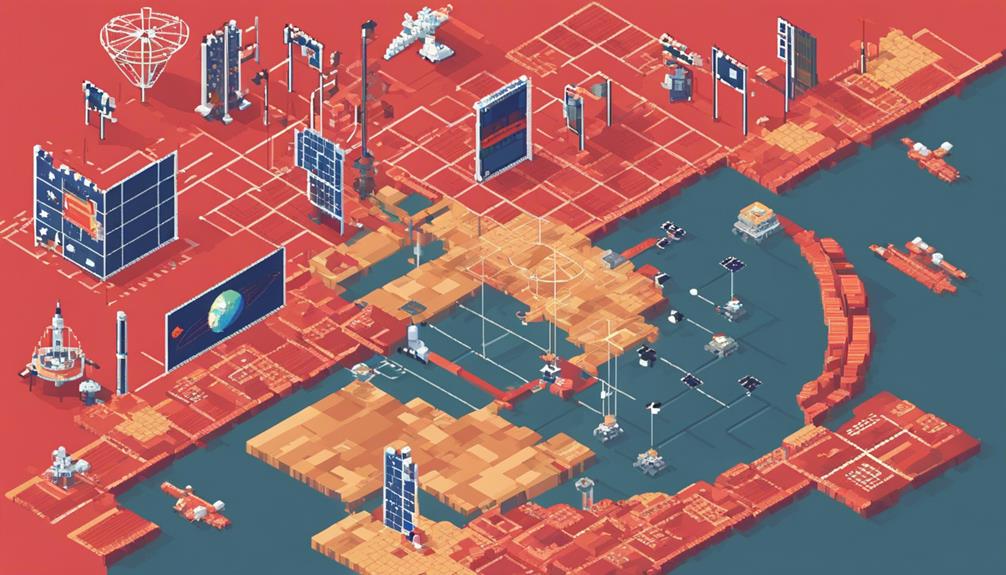Navigating the regulatory landscape for new satellite systems presents a multifaceted puzzle, requiring a nuanced understanding of licensing intricacies, spectrum coordination challenges, and compliance with international standards. As the space industry progresses with propulsion innovations and increased data capabilities, ensuring effective regulatory oversight becomes paramount. The complexities surrounding orbital debris management, environmental impacts, and harmonizing global regulations present a compelling backdrop for examining the intricate web of challenges faced by satellite operators. In an era of rapid technological advancements, the conversation around regulatory frameworks for satellite systems promises to unravel a tapestry of critical considerations that demand collective attention and strategic solutions.
Key Takeaways
- Navigating complex licensing landscapes is crucial for new satellite systems.
- Spectrum allocation strategies must be carefully managed to mitigate interference risks.
- Effective orbital debris management is essential for safe and sustainable satellite operations.
- International regulatory alignment is key to overcoming challenges and promoting innovation in the satellite industry.
Licensing Requirements

When establishing new satellite systems, navigating the complex landscape of licensing requirements is imperative for satellite operators seeking to comply with national regulations and international standards. Licensing applications for these systems encompass various crucial aspects such as spectrum usage, orbital debris mitigation, and adherence to international regulations. Satellite operators must ensure that their systems operate within approved frequency bands, minimizing interference with other satellite services through meticulous frequency coordination with the International Telecommunication Union (ITU).
Moreover, compliance with orbital debris mitigation measures is a significant component of licensing requirements. Satellite operators need to demonstrate their commitment to responsible space practices to mitigate the generation of space debris that could endanger other spacecraft and satellites in orbit. This includes designing satellites that can be safely deorbited at the end of their operational life to minimize the creation of space debris.
In addition to national licensing frameworks, satellite operators must also adhere to international regulations set forth by organizations like the ITU to ensure harmonious operation of satellite systems globally. Failure to obtain the necessary licenses or meet regulatory requirements can lead to severe consequences, including penalties, operational restrictions, and possible disruptions to satellite services. Therefore, a thorough understanding and meticulous adherence to licensing requirements are paramount for the successful deployment and operation of new satellite systems.
Frequency Allocation Issues
Frequency allocation issues in satellite systems stem from the scarcity of available radio frequency spectrum, posing challenges in securing optimal bands crucial for system deployment. Amidst increasing competition among satellite operators, the need for effective spectrum allocation strategies intensifies to mitigate interference risks and ensure operational efficiency. Addressing these complexities is vital to prevent delays in system launches and uphold seamless connectivity services for sustainable satellite system growth.
Spectrum Allocation Concerns
Effective spectrum allocation management is crucial for the successful deployment and operation of new satellite systems. Spectrum allocation concerns revolve around assigning specific frequency bands for satellite communication, impacting the efficient use of limited spectrum resources. Balancing the spectrum access needs of various satellite operators while addressing interference mitigation is challenging. Regulatory frameworks play a vital role in managing spectrum allocation concerns to support the growth of new satellite systems. Smooth operation of diverse satellite services relies on effective spectrum management to prevent conflicts.
| Spectrum Allocation Concerns | Satellite Operators | Regulatory Frameworks |
|---|---|---|
| Assignment of frequency bands | Spectrum access needs | Legal guidelines |
Interference Mitigation Strategies
Implementing robust interference mitigation strategies is paramount for new satellite systems facing frequency allocation challenges. Spectrum management plays a critical role in ensuring that satellite networks operate efficiently without causing harmful interference. Regulatory requirements mandate that satellite systems adhere to specific frequency coordination protocols to minimize the risk of signal disruptions. Effective interference mitigation strategies not only help in optimizing spectrum use but also contribute to the overall reliability and performance of satellite communication systems. By following clear guidelines for frequency management, satellite operators can proactively address interference issues and prevent conflicts that may arise due to overlapping frequency assignments. Prioritizing interference mitigation is essential for the successful operation of new satellite systems in a crowded orbital environment.
Orbital Debris Management

Orbital debris management plays a critical role in safeguarding the integrity of space operations by monitoring and mitigating space debris to prevent potential collisions with satellites and spacecraft. The sustainability of space activities heavily relies on effective debris removal strategies and proactive measures to address the challenges posed by the increasing population of space debris.
Key Points:
- Rising Concerns: The escalation in satellite launches has led to a proliferation of space debris, intensifying concerns about the safety of orbital activities. It is imperative to address this issue promptly to ensure the sustainability of space operations.
- International Collaboration: International dialogues are underway to devise comprehensive strategies for debris removal and to formulate guidelines for preventing the generation of additional space debris. Collaborative efforts are crucial in tackling this global challenge.
- Technological Innovations: Space agencies and organizations are actively exploring advanced technologies such as active debris removal to clean up the existing debris in orbit. These innovative solutions are essential for the efficient management of space debris.
- Long-Term Sustainability: Ensuring effective orbital debris management is fundamental for the long-term sustainability of space activities. Mitigating the risks associated with space debris is essential to prevent catastrophic collisions and safeguard the future of space exploration.
Environmental Impact Considerations
Incorporating environmental impact considerations into satellite system design and operation is crucial for mitigating risks associated with space debris and ensuring the sustainability of space activities. The proliferation of satellite systems has led to an increase in space debris, with more than 26,000 objects larger than 10 cm and approximately 128 million smaller debris particles posing a threat to space operations. Environmental concerns primarily revolve around the potential for collisions among these objects, which could generate even more debris, further endangering operational satellites and crewed missions.
To address these challenges, space agencies and satellite operators are implementing strategies for space debris mitigation. One key aspect involves designing satellites with safe disposal measures, such as deorbiting or reentry at the end of their operational life, to minimize long-term orbital debris risks. Additionally, post-mission disposal guidelines and debris mitigation plans are being developed and enforced to limit the environmental impact of satellite systems.
Regulatory frameworks play a vital role in promoting environmental sustainability in space activities. These frameworks encompass spacecraft design standards, launch vehicle practices, and end-of-life disposal requirements to ensure that satellites are developed, operated, and retired in a manner that minimizes their environmental impact. By adhering to these regulations, the space industry can mitigate the environmental consequences of satellite operations and contribute to the long-term sustainability of space exploration.
International Regulatory Alignment

International regulatory alignment in the context of new satellite systems encompasses critical aspects such as global spectrum coordination and cross-border licensing requirements. The harmonization of regulations in these areas is essential for fostering seamless satellite operations across different countries. By addressing these points, satellite operators can navigate regulatory complexities more efficiently, enabling enhanced collaboration and innovation in the satellite industry.
Global Spectrum Coordination
Efficient global spectrum coordination is paramount for ensuring international regulatory alignment in satellite systems, preventing interference, and optimizing spectrum use.
Key Points:
- Harmonization: Global spectrum regulations harmonization facilitates efficient satellite operations.
- Cross-Border Coordination: Promotes effective cross-border frequency coordination.
- Role of International Agreements: ITU Radio Regulations are pivotal for coordinating spectrum use.
- National Alignment: Aligning national spectrum policies with international frameworks prevents conflicts and ensures fair spectrum resource access.
Effective global spectrum coordination is crucial for the successful deployment and operation of new satellite systems worldwide. It not only fosters cooperation among nations but also enhances the overall efficiency and reliability of satellite communications.
Cross-Border Licensing Requirements
Ensuring seamless operation of satellite systems across borders necessitates meticulous alignment of cross-border licensing requirements to meet regulatory obligations in multiple jurisdictions. International regulatory alignment is essential for the efficient transmission of satellite signals globally. Harmonizing licensing requirements aids satellite operators in navigating the intricate legal frameworks present in various countries when deploying systems. Challenges may surface due to disparities in national regulations, highlighting the need for coordination to fulfill cross-border licensing obligations successfully. By streamlining cross-border licensing processes, the deployment of new satellite systems on a global scale can be facilitated, promoting the interoperability and effectiveness of satellite communication networks. International alignment of cross-border licensing requirements is paramount in addressing regulatory challenges and ensuring the smooth operation of satellite systems worldwide.
Compliance With Export Controls
Compliance with export controls is a fundamental requirement for satellite operators seeking to navigate the intricate regulatory landscape governing the transfer of sensitive satellite technologies. Ensuring adherence to regulations like ITAR (International Traffic in Arms Regulations) and EAR (Export Administration Regulations) is crucial for satellite operators in the space industry. Here are key points to consider regarding compliance with export controls:
- Legal Obligations: Satellite operators must comply with export controls to prevent the unauthorized export of technologies that could pose national security risks. Understanding and following export control requirements is essential for responsible operation within the satellite industry.
- Licensing Requirements: Certain satellite systems utilizing specific technologies or components may necessitate obtaining export licenses to ensure compliance with export control laws. Failure to secure the required licenses can lead to severe penalties and legal consequences for satellite operators.
- Risk Mitigation: Compliance with export controls helps mitigate the risk of sensitive satellite technologies falling into the wrong hands, safeguarding national interests and maintaining the integrity of the satellite industry.
- Operational Consequences: Non-compliance with export controls can result in significant fines, sanctions, and reputational damage for satellite operators. It is imperative for operators to proactively address export control requirements to operate legally and responsibly.
Spectrum Coordination Challenges

The escalating proliferation of new satellite systems globally is intensifying spectrum coordination challenges. With the rapid increase in satellite deployments, effective spectrum coordination is crucial to manage the allocation of frequencies and prevent interference issues. This is particularly true for Non-Geostationary Satellite Orbit (NGSO) satellites, which are being launched in large constellations, further complicating the coordination process.
| Spectrum Coordination Challenges |
|---|
| 1. Increasing number of satellite systems |
| 2. Complexity in spectrum allocation and coordination |
| 3. Escalating interference risks |
| 4. Balancing spectrum needs among operators |
| 5. Importance of International spectrum coordination |
The interference risks associated with the proliferation of satellite systems highlight the need for robust coordination mechanisms to avoid disruptions in services. Balancing the spectrum requirements of different satellite operators is essential to prevent conflicts and ensure efficient use of available frequencies. International spectrum coordination plays a vital role in harmonizing the utilization of frequencies across borders, reducing interference issues, and fostering cooperation in the satellite industry. As the satellite ecosystem continues to expand, addressing spectrum coordination challenges becomes increasingly critical to maintain the integrity and effectiveness of satellite communications.
Regulatory Oversight for Remote Sensing
Amidst the spectrum coordination challenges faced by the growing number of satellite systems, regulatory oversight for remote sensing satellites emerges as a critical aspect necessitating compliance with national and international laws. Remote sensing satellite operators must navigate a complex regulatory framework to ensure their operations meet legal standards and obligations. Key considerations in this domain include:
- Licensing Requirements: Remote sensing satellite operators are required to obtain licenses from relevant regulatory bodies, such as the Federal Communications Commission (FCC) in the United States. These licenses outline the conditions and parameters under which the satellites can operate, ensuring adherence to established guidelines.
- Data Protection: Compliance with data protection and privacy regulations is paramount for remote sensing satellite operators. Given the sensitive nature of the information collected and transmitted by these satellites, stringent measures must be in place to safeguard data and ensure privacy rights are respected.
- Regulatory Framework: Regulatory frameworks governing remote sensing satellites often include restrictions on image resolution, data sharing practices, and geographic areas of operation. These frameworks aim to strike a balance between fostering innovation and commercial opportunities while addressing national security and public interest concerns.
- Space Law Compliance: Remote sensing satellite operators must also adhere to space law principles and international agreements to ensure responsible and lawful conduct in outer space activities. This includes respecting treaties and conventions that govern space exploration and satellite operations.
Streamlining Licensing Procedures

With a focus on enhancing operational efficiency and reducing regulatory barriers, the optimization of licensing procedures for new satellite systems is paramount in fostering innovation and growth in the satellite industry. Streamlining licensing procedures holds the potential to significantly reduce administrative burdens on operators. By implementing efficient licensing processes, the deployment of satellite networks and services can be expedited, leading to quicker access to advanced technology for consumers. Moreover, simplified procedures not only encourage innovation but also attract investment in the satellite industry, driving economic growth.
For small satellite operators, clear and transparent licensing frameworks are particularly beneficial as they help navigate the complex regulatory requirements more effectively. Understanding the licensing procedures and requirements is crucial for these operators to ensure compliance while minimizing delays in bringing their services to market. Furthermore, international harmonization of licensing procedures can play a vital role in promoting consistency across different regions and facilitating cross-border satellite operations. Consistent regulations streamline the process for satellite operators working in multiple countries, promoting a more cohesive and efficient global satellite network. Overall, the harmonization and simplification of licensing procedures are essential steps towards advancing the satellite industry and maximizing its potential for innovation and expansion.
Frequently Asked Questions
What Will Be the Biggest Challenge for the Satellite?
Facing the satellite system, the paramount challenge lies in orchestrating interference mitigation strategies to preserve signal integrity amidst a cacophony of frequencies. Orbiting through cluttered celestial pathways, the menace of orbital debris looms large, necessitating meticulous navigation protocols. Securing a slice of the spectrum allocation pie is imperative for unhindered data transmission. Adherence to stringent licensing requirements serves as the cornerstone of regulatory compliance, ensuring operational legitimacy and environmental responsibility.
What Are the Major Problems of Satellites?
Space debris, orbital collisions, frequency coordination, and spectrum allocation are major issues faced by satellites. The proliferation of satellites increases the risk of collisions and contributes to space debris. Coordinating frequencies to prevent interference between satellite systems and other users is crucial. Allocating spectrum efficiently is essential for optimal satellite operation. Addressing these challenges is vital for ensuring the safety and effectiveness of satellite systems in orbit.
How Are Satellites Regulated?
Satellites are regulated through a complex framework that involves licensing requirements, frequency allocation, national security concerns, and orbital debris management. Regulatory bodies oversee satellite operations to ensure compliance with international treaties and national laws. Operators must obtain authorization for launches and adhere to ITU regulations for frequency coordination. Ground segment operations, including satellite landing rights and frequency licensing, are integral to ensuring the safe and responsible operation of satellites.
What Are Some Challenges in Communicating With a Satellite?
Communicating with satellites presents challenges such as signal interference, orbital debris risks, space weather impact on signal reliability, and efficient data transmission. Signal interference can disrupt communication quality, while orbital debris poses collision hazards. Space weather events like solar flares can affect signal strength. Ensuring secure and reliable data transmission requires overcoming these obstacles through advanced technologies and precise operational strategies to maintain uninterrupted communication with satellites.
